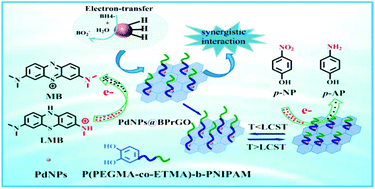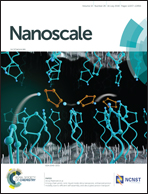Mussel-inspired construction of thermo-responsive double-hydrophilic diblock copolymers-decorated reduced graphene oxide as effective catalyst supports for highly dispersed superfine Pd nanoparticles†
Abstract
Well-dispersed ultrafine palladium nanoparticles supported by reduced graphene oxide functionalized with catechol-terminated thermo-responsive block copolymer (PdNPs@BPrGO) were successfully constructed for highly efficient heterogeneous catalytic reduction. We first synthesized a novel temperature-responsive episulfide-containing double-hydrophilic diblock copolymer, poly(poly(ethylene glycol) methyl ether methacrylate-co-2,3-epithiopropyl methacrylate)-block-poly(N-isopropylacrylamide) (P(PEGMA-co-ETMA)-b-PNIPAM), through a reversible addition–fragmentation chain transfer (RAFT) polymerization utilizing a chain-transfer agent with a catechol unit as the end group. The obtained block copolymers can be facilely anchored to the surface of GO via mussel-inspired chemistry. The PdNPs were loaded on GO decorated with block copolymer brushes (BPrGO) as a support via the in situ reduction of palladium precursors with the episulfide ligands of the block copolymer as a stabilizer. The resulting PdNPs@BPrGO nanohybrid catalyst had good water dispersibility and stability. Furthermore, a low dosage of PdNPs@BPrGO catalyst exhibited excellent catalytic performance in the reduction of methylene blue and nitrophenols. The performance was attributed to the ability of PdNPs@BPrGO to facilitate the diffusion of reactants compared to PdNPs@GO without polymer modification. PdNPs@BPrGO also possessed an interesting temperature-responsive catalytic property due to the reversible “coil-to-globule” phase transition behaviour of PNIPAM blocks onto the surface of catalyst. The PdNPs@BPrGO catalyst was successfully recovered and reused five times without any detectible loss in catalytic activity, demonstrating its great potential in a wide range of industrial catalytic applications.



 Please wait while we load your content...
Please wait while we load your content...